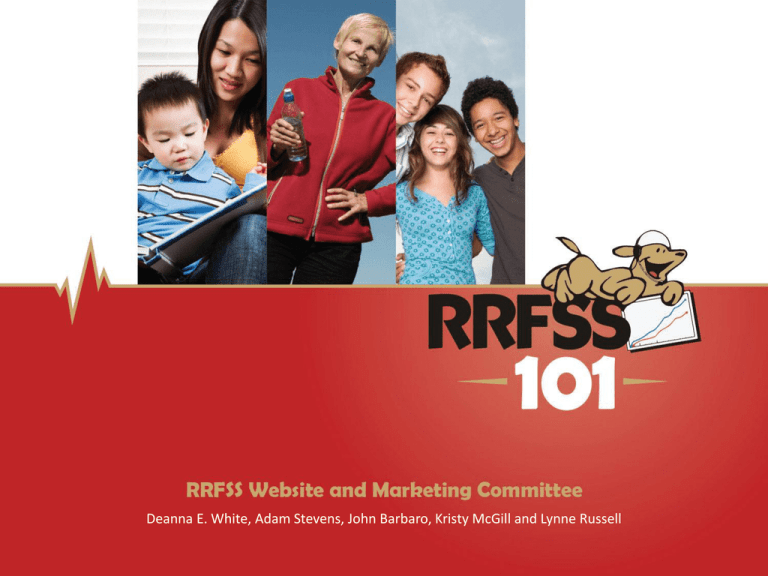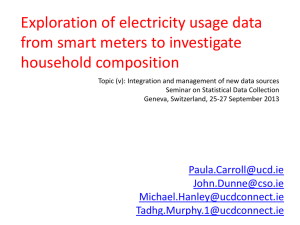
Deanna E. White, Adam Stevens, John Barbaro, Kristy McGill and Lynne Russell
2
Rapid
What is RRFSS
Risk Factor
Surveillance
System
3
Able to Monitor
Key Public Health Issues
Family History
Obesity
Hypertension
Diabetes
Smoking
4
Adaptable
to New Public Health Issues
5
Local
6
Timely
7
How Can We Use RRFSS?
• To support program planning
and evaluation
• To advocate for public policy
development
• To improve community
awareness of risks for CDs,
IDs and injuries
8
Who Can Join RRFSS?
Any Public
Health Unit
in Ontario
… but there
is a cost.
9
When is the
Survey Conducted?
• There are three
4-month data cycles
per year.
10
How is Data Collected
• Institute for Social Research
(ISR) at York University
11
How Long is the Survey?
12
How is the Questionnaire
Organized?
13
• Decided annually by all participating HUs
• Asked for at least one year
• May rotate alternating years
• Mandatory – CANNOT opt out of these
AGE
SEX
BMI
TOBACCO
USE
INCOME
14
• Selected by each HU individually
• Can add or delete each cycle
15
What are some of
the Topics/Modules?
See Q
Map
Your Turn!
Are there any topics you
would be interested in?
Please circle the topic.
16
Must We Use the
Entire Module?
No
But …
• Must start at the beginning
of a module
• Cannot jump back in once
stopped
17
Can We Develop
Modules?
Yes
but you must follow
a process:
• Complete Module Submission
Request Form
• Should be applicable to
multiple PHUs
• Can work with your own if no
other PHU interested
18
How to Choose Optional
• Align with health unit’s data needs
• Measure the variable over time
(decrease in chronic disease prevalence?)
• Data is not available from other data sources
(use and awareness of parenting programs)
19
What is the Sample Size?
400
interviews/HU
3
cycles/year
1,200
interviews/year
RRFSS has a larger sample size than the CCHS in some PHUs.
20
Who is Included
in the Sample?
• 18 years of age and older
• English or French speaking
• Reside in private homes
• With landline
* some cell phone numbers
were included
21
Is the Sample Size
Big Enough?
22
Sampling Procedures
• Random selection of households
– using random digit dialing
• Random selection of respondent
– household member with next birthday
23
Household Weights
• Maximize ability to
generalize the survey
results (the sample) to
the population
• Probability of selection
depends on size of
household
24
Household Weights
Size of
Household
Chance
Selected
1
adult
100%
Given weight of 1
2
adults
50%
Given weight of 2
3
adults
33.3%
Given weight of 3
Weight
This helps to prevent underrepresentation in larger households
and over-representation in small
households.
25
So, is it Still
Representative?
Calculations were used to determine sample size
for results to be generalizable
26
Is the Survey
Valid & Reliable?
Yes!
• Modeled on the Behavioural Risk Factor
Surveillance System (BRFSS) conducted
by the Centres for Disease Control and
Prevention (CDC) in Atlanta
• Many questions also taken from the
CCHS and the National Population
Health Survey (NPHS)
• The original design was tested for
reliability and validity
27
How Do We Ensure
Accurate Results?
• Confidence intervals &
coefficient of variation
28
The Confidence
Interval (CI)
• How confident are we in the point estimate (i.e., value)?
• E.g., 6% … (85% CI: 3% - 9%). What does 95% mean?
• … based on probability.
29
Probability
30
Probability
31
Probability
32
Significance Testing
Statistically Significant
NOT Statistically Significant
• Likely happened
• The results are probable
• It could have happened
by chance alone
What does this have to do with the CI?
33
Significance Testing
• We use the CI to determine whether something is
statistically significant.
• If the CIs do not overlap than they are SS
• Example: Percentage of females vs males who smoke:
Females:
70% (60%-80%)
Males:
30% (20%-40%)
Your Turn!
Please complete section
one. Circle statistically
significant statements.
34
35
Coefficient of Variation
• Refers to the precision of the estimate
• Usually a result of small numbers (i.e., 2/800)
• Interpret with caution presented with an *asterisk
• An empty cell means the value is not precise
(in fact, incorrect), so we cannot
report this number
Your Turn!
Please circle the asterisk
in the table.
36
RRFSS is Self-Reported?
Are there limitations to this?
37
Distorted Perceptions
38
Distorted Perceptions
39
Hawthorne Effect
In groups of
two, please
answer the
following …
How many times per day, week
or month do you drink 100%
fruit juices such as orange,
grapefruit, or tomato juice?
How often do YOU wear a
seatbelt when YOU DRIVE a car,
van or truck: Would you say, all
of the time, most of the time,
about 1/2 the time, less than
1/2 the time, or never or almost
never?
40
Memory Recall
What is the total amount of
time you spent sitting, last
Wednesday? (hours & minutes)
41
In groups of
two, please
answer the
following …
Sensitivity
What is your age?
How much do you weigh?
In your lifetime, have you
Ever had suicidal thoughts?
What is your yearly total
Income (before taxes)?
42
Self-Reported Measures
43
What RRFSS Recall








